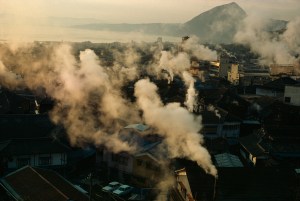
Beppu, Japan uses geothermal energy for heat (Getty)
On Sunday, over 17,000 people took to the streets of Tokyo to let their government know they’ve had it with nuclear power. It was an unusual display of mass disgruntlement in the Japanese capital, but these are unusual times. Residents walked through the neighborhood of Koenji – reportedly the birthplace of Japanese punk – with dogs and children in tow, shouting out against the radiation and other bad news that have been spewing forth from the Fukushima Daiichi nuclear power plant since it was crippled in the March 11 earthquake. One man carried a printed sign that read “We are killed now by ATOMIC ENERGY MAFIA!” On a more constructive note, another bore the message “Yes We Can Change to Clean Energy.”
“I don’t want nuclear power to be what we hand onto the next generation,” said Leona Yuyama, a 36-year-old mother who was marching with all of her four young children. “When I look at [my kids’] faces everyday, I keep thinking about the dangers of nuclear power and what they will have to face in the future.” Like several other demonstrators around her, Yuyama is in favor of Japan considering its other energy options. “We need to switch to geothermal power.”
(See TIME’s full coverage of the Japan quake.)
Could the tectonic activity that caused today’s crisis in Japan be part of making sure it doesn’t happen again? Located on the Pacific “Ring of Fire,” human inhabitants of the northerly archipelago have always tapped into the hot subterranean water to build baths and heating systems for homes and agriculture. Japan has, in fact, been using more direct geothermal heat than any other nation for centuries. Despite its small size, it has the third largest geothermal energy potential in the world after the U.S. and Indonesia. But in terms of harnessing that heat and turning it into power, Japan only ranks 8th, after countries with drastically smaller populations, like Iceland and New Zealand. Today, Japan only generates about .1% of its electricity in 19 geothermal energy plants, many of which are located in the Tohoku region where the Fukushima nuclear power plant is located.
It’s a little surprising that more hasn’t been done on the geothermal front when you consider that Japan is also world’s third largest electricity consumer. (The U.S. and China come in first.) Japan imports more liquid natural gas (LNG) and coal than any other nation, and it’s the third largest consumer and net importer of oil. Since the oil crisis in the 1970s, nuclear power has been the energy source Japan has looked to to decrease its dependence on foreign oil. In 2008, nuclear energy accounted for 24% of the nation’s electricity consumption. Before March 11, the government was on track to raise that figure to 40% by 2017 and 50% by 2030, in part by building over a dozen new reactors.
It’s hard to imagine that plan surviving Fukushima, and renewable energy companies, which have been largely shut out of Japan, are licking their chops at the prospect. Though Japan has not fully exploited its geothermal potential domestically, Mitsubishi, Toshiba and Fuji Electric are all major manufacturers of geothermal equipment. Together, they supply about 70% of the steam turbines and power gear used internationally, according to Reuters, and they could stand to benefit greatly if there were a geothermal boom. (Toshiba, which had a hand in building 4 of the reactors at Fukushima, has put in bid for the lucrative decommissioning of the stricken plant once the emergency phase is over. Hitachi, which supplied one of the reactors, has put in the other bid.)
Geothermal power plants, once up and running, provide extremely cheap power with very low emissions. But the sector faces some serious challenges, not the least of which is getting investors onboard. Geothermal’s front-end cost is high in order to assess sites for potential and do exploratory drilling that doesn’t always pan out. Many people worry that the drilling, particularly for the kind of very deep wells which yield the most power, will cause geologic instability, which, considering that most places where geothermal potential exists are also places where people live with earthquakes, can be a hard sell.
(Watch a video about geothermal energy in Iceland.)
Geothermal power plants also aren’t all that pretty. They release a lot of steam into the air and rely on networks of above-ground piping that can be a bit an eyesore. That particular problem is exacerbated in Japan, where the same areas in which geothermal potential is the highest are revered for their natural beauty and centuries-old onsen, or baths. There are nearly 8000 spa resorts around the country, attracting an annual 140 million bathers. In recent years, some members of the onsen industry who say the plants will disturb the baths have butt heads with Tokyo’s push for more small geothermal plants to be incorporated into localized energy portfolios.
But that might change: many of the onsen are located in the devastated northeast. A plume of steam from a geothermal plant on the horizon might not be ideal for an industry that relies on its bucolic charm to lure customers, but nothing it’s hard to imagine anything worse for business than the specter of radiation that will hang over this part of the nation for decades.
—With reporting by Lucy Birmingham / Tokyo


